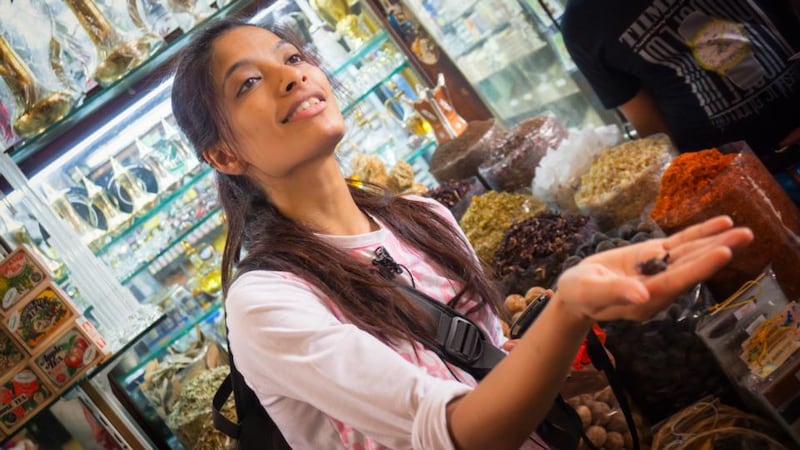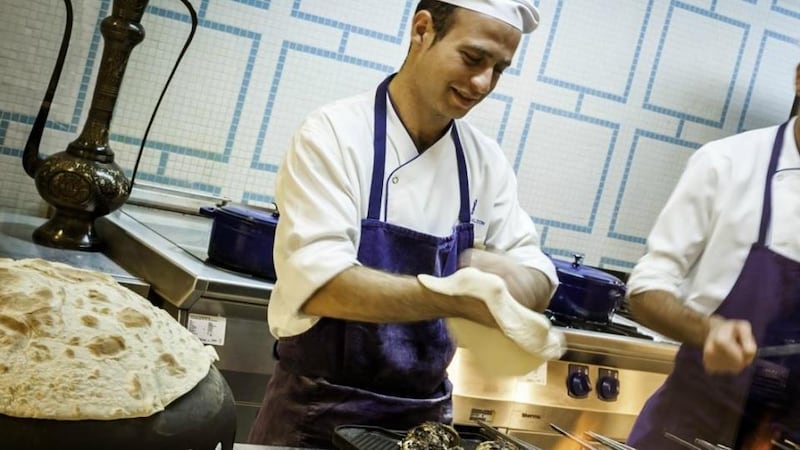The three severed camel heads loll to one side, eyes mercifully closed, big yellow teeth bared in a final rictus grin. They still have their shabby fawn skin attached, and they’re being stared down by an even more startling sight: another camel head, this one skinned and ready for the pot, eyes wide open.
“This is an intense place,” says Arva Ahmed. “You’ll see things you probably won’t have seen before, and there’s a strong smell. But don’t worry – you’ll be part of the smell after a few minutes.”
A visit to Dubai’s fish, meat and vegetable market at Deira comes with this warning from Ahmed, whose tour company, Frying Pan Adventures, runs a variety of special-interest tours of the city.


The Food Lover’s Morning March, which runs from early morning till after lunch, is a fascinating immersion into a side of Dubai that promises to break the bubble of artifice and take us to where the “ordinary people” of Dubai shop and eat.
“There’s a whole other side to the gilded, skyscraper Dubai. And there’s no better way to explore it than with your tummy,” promises the website for Frying Pan Adventures, which Wharton MBA graduate Ahmed runs with her sister Farida.
For almost seven hours we follow Arva, a former New York management consultant and self-confessed food fanatic, around the produce market and spice souk as she deciphers some of the secrets of Emirati cooking. She identifies spices and ingredients that our band of food explorers from Ireland, the UK, the US and Iran have never even heard of, never mind smelled and tasted. It’s all very heady, exotic and a million miles away from the sterile, air-conditioned bubbles of Dubai’s endless malls and glitzy hotels.
“To experience a city, you have to go into the backstreets and the markets,” Ahmed says. “Even if you don’t speak the language, if you speak food, you can connect.” She hands out latex gloves so we can check the fish for freshness at the market, a practice that is expected rather than frowned upon.
Passing through the cleaning section, where buyers bring their purchases to be gutted and scaled by legions of Pakistani and Indian workers wielding filleting knives, we learn that the most assiduous cooks will stand over their chosen “fish chopper” to make sure a good job is done. Fish eggs, if found, are a perk of the job, we learn, sold on to supplement the workers’ meagre wage.
In an immense hall filled with fish stalls, Norwegian salmon sits alongside local Gulf fish.
“The expat buys what they are used to at home,” Ahmed observes wryly. The stalls at the edge of throng are dearer to rent, and have the freshest fish. “We don’t buy from the stalls in the centre.”
Impromptu fish auctions take place just outside the market. In front of us a fisherman drops his catch onto a jute bag and a crowd immediately assembles, to pick over the still moving catch. Bidding begins, and within minutes it’s all over. The buyers are canny shoppers, many of them able to tell just by looking at a fish whether it was cage or line caught, Ahmed tells us.
Later, in the bewildering, hectic, and quite touristy spice souk, we stick close to our guide as she leads us through hot, heaving passages to the holy grail: a stall selling saffron, the most expensive spice in the world, and a relative bargain here, in one of the world’s most expensive cities.
In Ahmed Hussain Ali Trading, we are introduced to the owner, Mr Reza, and presented with three giant glass bowls of the ruddy red crocus filaments. Ahmed tells us we should go for the best quality Sargol saffron and barters persistently but politely on our behalf (“always look devastated when they quote the first price”) until she gets it down to eight dirham (€2) a gram, a fraction of what it might cost at home.
To the saffron, carefully weighed and presented in a decorative glass box, we add loomi, the dried black limes that pop up in Ottolenghi recipes, and bags of dried shallots, which Ahmed tells us to rehydrate overnight the mix with yoghurt, dried mint and salt to make a dip for flatbread.
There are also refuelling pitstops in our marathon food discovery session. A 10-minute, one dirham (25 cent) glide across the Dubai Creek in a wooden boat called an abra leads us to Creekside, a contemporary waterside gallery and restaurant. The al fresco breakfast is an Emirati scramble – eggs with tarragon butter and black truffle served with rgag, a paper thin crispy bread made only with flour and water, and glasses of rose iced tea.
Coffee is taken at a charming small museum dedicated to the drink, thought to have originated in Ethiopia and now the beverage that welcomes visitors to every Emirati home, served with dates in place of sugar. Museum curator Arezou Schulz, of German and Iranian descent, shows us through the museum’s exhibits relating to the growing, roasting and grinding of the beans.
For lunch, we head out of town by minibus to Ahmed’s favourite kebab shop, in a residential area near the airport, which she describes as “a hole in the wall”, and which sends out platters of food to be eaten by customers sprawled on rugs laid out on the ground in the car park.
You won’t find the Al Fareej restaurant and bakery in any guide books or in Dubai restaurant listings, but as Ahmed promises, the drive-by suburban shop serves excellent food. And, unusually for Dubai, it’s cheap: around €8 for an all-you-can-eat feast.
Served first are platters of hot flatbreads, salad leaves and silky smooth hummus, decorated with pools of fragrant olive oil and drifts of lemony sumac. They are followed by dishes of rice with barberries, and giant skewers the size of swords on which are impaled kebab koobideh (twice-minced lamb kebabs), chicken tikka, and, best of all, lemon lamb tikka.
The pungent, almost fizzy lemon flavour on the grilled meat comes from loomi, those dried black limes we purchased at the souk, ground down to a powder and dusted on the meat before grilling.
It’s a wonderful feast, rounded off by a sticky spoonful of Omani halwa from the bakery, made with tapioca starch, cardamom, clarified butter, caramelised sugar and nuts. Best of all, it’s a welcome slice of informality and normality, in a city where those can be hard to come by.
The Food Lovers' Morning March with Frying Pan Adventures costs AED 520 (€130), including breakfast, lunch and all transfers. See fryingpanadventures.com.
Three nights B&B at the Ritz Carlton Dubai costs from £819/€1,126 per person, including direct flights with Emirates from Dublin. Book and travel by July 15th. See travelbag.co.uk and, for departures from Ireland, tel: 00-44-845-5436615.
For more information on visiting Dubai, see dubaitourism.ae.
Desert Safari
kay, so you’re probably not going on a dune bashing (or “sand slapping” as one of our group called it) expedition – pictured above – for the culinary highlights. But there is something magical about eating dinner sitting cross-legged on carpets in the middle of the desert, under starlight.
The food is simple but delicious, like most things served in the open air. A buffet dinner of salads, flatbreads, barbecued meats and soft drinks is included in the AED 292 (€70) six-hour evening safari with Alpha Tours (alphatoursdubai.com). Camel rides and traditional dancing optional.
Market shopping
Yael Mejia, or Gail Stephens as she is perhaps better known in London, where she established the Baker & Spice bakeries and cafes, now lives in Dubai, where she is a consultant to a chain of three Baker & Spice outlets in the city.
But Mejia’s heart lies with an associated venture, The Farmers’ Market on the Terrace, a weekly food market that runs from November to the end of May in the car park of the city centre Jumeirah Emirates Towers hotel.
From 8am you’ll see her there, checking what bounty has come in from the desert farms, where irrigation schemes facilitate the growing of fruit and vegetables.
“When I came to Dubai to set up Baker & Spice,” she says, “one of my first tasks was sourcing local and regional fresh produce. I knew there was farming here and I just had to find it and connect.”
It took Mejia a year of “investigation, phoning, cajoling, travelling in the desert and begging”, to establish relationships with three farms. The market, a spin-off from her work in this area, is now in its sixth season.
Certified, locally grown, organic, sustainable and ethical labels all apply to the produce sold here. The variety is huge, with fresh produce now coming in from at least 12 farms.
Brunch bunch
Friday brunches are a popular way to start the weekend in Dubai. Most of the big hotels host them, and the Ritz Carlton’s Rotisserie Friday Brunch (below) at Caravan restaurant is one of the best in town.
Canadian Eric Melouche is executive chef, having previously ran the kitchen of the former Ritz Carlton in Powerscourt. He says he loved Ireland, but there is no doubt that chef Melouche is enjoying Dubai’s “anything’s possible” vibe.
“We manage a tremendous food budget, but we don’t have the same pressure to cut costs,” he says. “It’s more about let’s do something exciting that’s going to be profitable.” Irish beef and cheese feature in the hotel’s menus. “Cooleeney, Wicklow Blue and Coolattin cheddar for our club lounge and breakfast buffet.”
It’s hard to spot them among the vast array of shellfish, sushi, salads, dedicated pork and charcuterie counter, rotisserie meats, curries, Middle Eastern specialities and patisserie on offer at brunch. Every Friday (1-4pm), the clatter of heels on marble floors is the backtrack to an oyster, lobster and foie gras feeding frenzy. Brunch is accompanied by a drinks package, priced according to whether you want mocktails and soft drinks, or Moet, cocktails, premium wines and spirits.
Hotels are one of few places where alcohol is served in Dubai, and Friday brunch is party time. Brunch at the Ritz Carlton, with the unlimited premium drinks package, is AED 690 (€172); with soft drinks only it is AED 480 (€120).
















